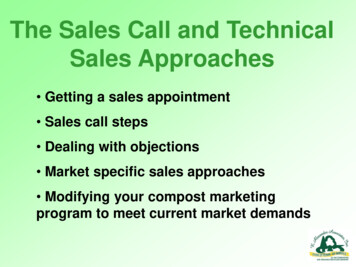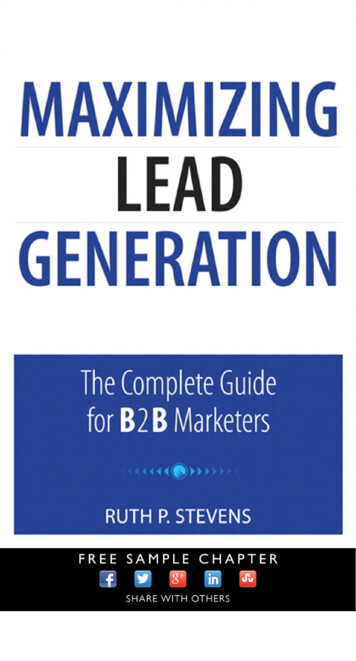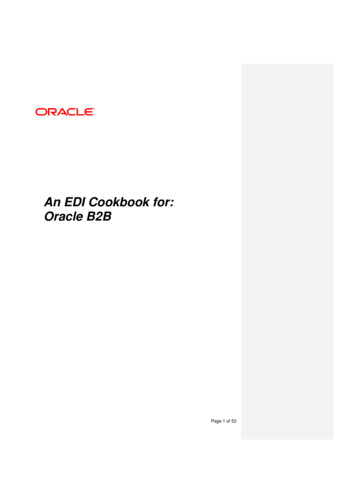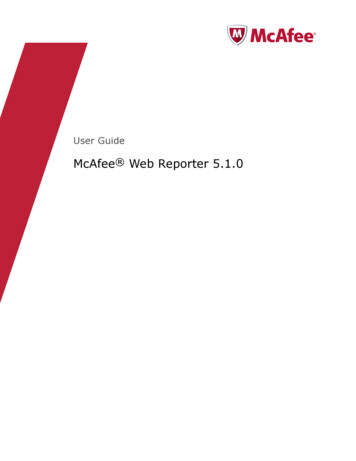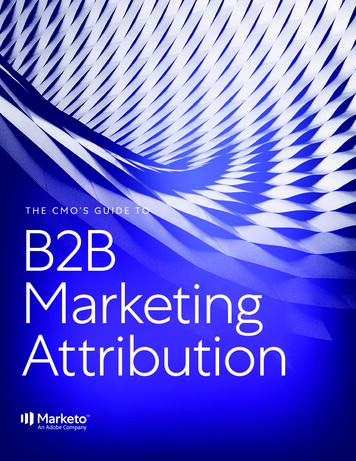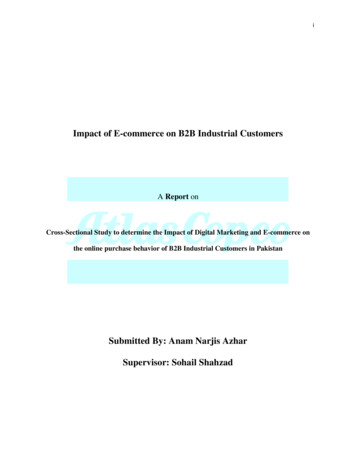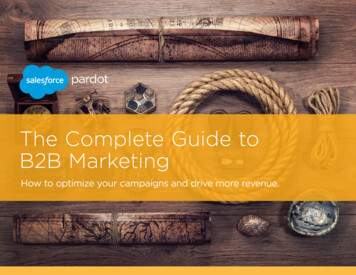
Transcription
3FORWARDThe B2BSales Planning Handbook(Everything Sales Leaders Need to Knowto Create a Winning Sales Plan!)Sales Leaders Success Kit 3FORWARD, LLC, All Rights ReservedCopyright holder is licensing this under the Creative Commons License, Attribution-No Derivative Works 3.0 3.0/. All trademarks are those of their respective companies. Please feel free topost this document in its entirety in your blog or email it to anyone you feel would benefit from reading it. Thank you
Sales Leaders Success KitExecutive SummarySales leaders, our B2B Sales Planning Handbook is intended to help you reach your revenue goals, fasterand more efficiently. We wrote this to deliver value immediately, regardless of where you might be in yoursales planning cycle or sales year. Besides fine-tuning your planning fundamentals, we hope it helps youbecome a more inspired, focused and effective sales manager.A solid sales plan takes you from where you are now, to where you want to be. In short, it is thedifference between Making it happen vs. Hoping it happens!We’ve packed this Handbook with simple, strategic sales insights that you can use every day. While someof this may confirm what you already know, we hope you glean a tip and technique or two that mayimprove your goal-setting practices, sales pipeline, selling process and sales measurements.For sales leaders like you, the scope of your work goes well beyond selling. It covers the trickier elements ofsales plan creation, territory and market segmentation, key performance indicators and a whole lot more.We believe that creating a formalized selling process helps build a stronger, more agile sales department.Enjoy this sales planning handbook, and we would be happy to hear your feedback.Sincerely,Dan Hudson and Matt Smith3FORWARD
Table of ContentsChapter 1: Setting Sales Goals and Targets1The Big Picture Approach1Defining Goals, Challenges and Investments2More Effective Approaches to Investing in Sales Success3Additional Resources for Setting Sales Goals and Targets3Chapter 2: Build the Revenue Model4A Reliable Sales Pipeline – the Foundation for Revenue Planning4Creating Your Revenue Plan5Find the Gaps In Your Pipeline6Measuring Pipeline Velocity7Additional Resources for Building the Revenue Model7Chapter 3: Fill The Funnel8Define Your Perfect Prospects8Define Your Lead Funnel Requirements8Creating Quality Leads9Pipeline Checkup Checklist10Additional Resources for Filling the Funnel10Chapter 4: Creating a Selling Culture11Is it Time for a Sales Transition?11Sales Territory Planning11Improving Your Sales Process12Additional Resources for Creating a Sales Culture15Chapter 5: Execute & Measure16Define Your Sales Leaders Dashboard16The Basic Set of Sales Key Performance Indicators16Additional Resources for Executing and Measuring18Wrap Up19About 3FORWARD193FORWARD’s Leadership19About the Authors20
Sales Leaders Success KitChapter 1: Setting SalesGoals and TargetsThe sales plan sets the road map for everything that goes into a successful sales year. It must answer twobasic questions: What revenue targets do you plan to achieve in the upcoming sales year? How are you going to achieve those targets?So, the opening section of the sales plan – Sales Goals and Targets –maps out your objectives and sets yourpath for the next year.T he B ig P icture A pproachThere’s a new year coming up and it’s time to start putting together your strategic sales plan. How canyou work smarter, not harder? How can you make sure you aren’t overlooking any opportunities? Start bystepping back and taking a “Big Picture” approach; look at everything going on around your company andindustry.Ask yourself these Pre-Planning questions: What factors might impact our sales results next year? How has our marketplace or prospect base changed in the last few quarters or years? Do I have to make adjustments to our sales process or sales support models? If I need to increase sales revenues next year (and who doesn’t?!), do I have the people in placeand the enabling technologies that will increase our sales efficiency? Are there any “leaks” in our sales pipeline, places where leads and sales opportunities couldslip through?Before you start planning your next year, here are some of the components of your sales plan that shouldreceive a fresh review each planning year. Sales environments and economic situations change quickly. Aselling strategy that made sense at one time may need dramatic revisions a year later. Lead Management Account Management Opportunity Management Territory / Area Management Pipeline Process Metrics and Reporting Team Skills Development Rep and Manager Recruiting CompensationSales environments andeconomic situationschange quickly. Aselling strategy thatmade sense at one timemay need dramaticrevisions a year later.Share:The B2B Sales Planning Handbook 3FORWARD, LLC, All Rights Reserved1
Sales Leaders Success KitNow, are you ready to get started and create your sales plan? Let’s talk about how to set realistic, actionablesales goals and targets D efining G oals , C hallengesandI nvestments1. Get SpecificAlthough goals and targets are often used synonymously, they are in fact quite different. Compare theirdefinitions1:Goals: Destinations or where weTargets: Specific results we wantwant the business to be and feel,the business to achieve, progressfor example: markers to attaining goals;– Relationships for example:– Reputation– Revenue– Image– Profit– Sustainability– Market share– Culture– RecognitionGoals and targets often work in tandem with each other. However, too often, sales goals and targets have acase of the “warm and fuzzies” – a feel-good tone that is vague and undefined. To be clear and actionable,goals and targets must be specific (numbers and dates are best) so that you can measure your progressthroughout the year.Example of “Fuzzy and Feel Good” TargetsEstablish new relationships for our US Financial andAccounting Outsourcing practice.Example of “Specific and Measurable” TargetsEstablish two new relationships per quarter in the USFinancial and Accounting Outsourcing practice. The targetedannual contract value of each new relationship is 2 million.When setting your goals and targets, try to strike the sweet spotbetween “go big or go home” and the reality of your marketsituation. Every company faces its unique market challenges, but ifyou are prepared, it makes it easier to overcome them.To be clear andactionable, goals andtargets must be specific(numbers and dates arebest) so that you canmeasure your progress2. Prioritize Challenges and Set Defensive StrategiesConsider your last couple sales years and think about those things that kept you from achieving all yoursales targets.Then, list out these challenges, their impact and priority, and start documenting your approach tominimizing these sales barriers. Use a template such as the following to identify, rank and address yourchallenges.*From our well-worn version of Marketing Plans that Work – Targeting Growth and Profitability, copyright2002.1Share:The B2B Sales Planning Handbook 3FORWARD, LLC, All Rights Reserved2
Sales Leaders Success KitPreparing for Sales Plan Risks and ChallengesChallengeNot enough qualified output from marketing’s lead generationprogram.AffectsThe sales pipeline and ability to make the annual revenue targetSeverityHighRecommendationMeet with Marketing to jointly define what constitutes a qualified lead.Accelerate identification of target accounts to increase lead funnel size.Assigned ToJoe KingComplete ByMarch 1, 20123. Define Changes and Investments Needed to Achieve SuccessYou are likely in the same boat as most sales leaders heading into a new year: You’re getting a quota increase.In the old days we might have grumbled a little, played around with territories and headcount then toldthe CEO we needed another seven sales reps to meet the new number. You based that number on yourexperience that one or two of the seven would make quota. Three or four would become permanent “B”players and the others would likely fail miserably.M ore E ffective A pproachesSales processimprovements basedon best-practicescreate permanentincreases in bothwin-rates and quotaattainmenttoI nvestinginS ales S uccessYes, headcount is still a critical success factor for a sales team expected to make its number.However, studies of best-in-class sales teams clearly demonstrate many other vital componentsto improving sales effectiveness and revenue results. These are more long-term, systemicimprovements that actually allow all members of your team to perform better and alsoimprove the success rates of future new hires.Sales process improvements based on best-practices create permanent increases in bothwin-rates and quota attainment for B2B sales teams. Here are some examples of these kindsof investments that you should consider. Establishing a formalized sales process, including targeted account planning Sales manager effectiveness training and industry-specific rep training Lead management process and a marketing automation system Sales leaders dashboard and sales knowledge management Sales intelligence, prospect profiling and industry monitoringThere you have an example of Setting Sales Goals and Targets, the first section in creating your new salesplan. You can clearly see why getting this area down on paper sets the stage for everything else in yourplan.A dditional R esourcesforS etting S ales G oalsandT argetsSales Revenue ForecastingSales Optimization Review for CEOs and Sales LeadersThe Complete 2012 B2B Sales Planning Outline And It’s Only 359 WordsProof That Sales Planning Increases Win RatesShare:The B2B Sales Planning Handbook 3FORWARD, LLC, All Rights Reserved3
Sales Leaders Success KitChapter 2: Build the RevenueModelYou’ve set your goals. You know the numbers you have to achieve. But, what’s your revenue model to getthere? It’s time to get down to the nitty-gritty by establishing a total, qualified value of your sales pipelineand translating that value into a reliable revenue projection.A R eliable S ales P ipeline –P lanningtheF oundationforR evenueBuilding a revenue plan is predicated on having an accurate, reliable sales pipeline. Unfortunately, toomany companies admit that pipeline accuracy is one of their biggest challenges. Before you can use yourpipeline to build your revenue plan there are three critical things you must do first to make it as accurateas possible:1. Know the difference between a lead and a prospect. Leads have no place in a salespipeline; the pipeline should contain only qualified opportunities. This seems very basic but somecompanies don’t differentiate between the two. From our viewpoint, here is the difference: A lead is a company that is in your target market and is strong or neutral fit based on yoursweet spot analysis. A prospect is a company that is actively looking to solve a problem or an issue, meetsthe above definition of a lead, will make a near to mid-term buying decision, and you areengaged at a decision maker level.2. Standardize on sales stages and definitions. One of the situations where sales pipelineslose credibility and accuracy is when different stages mean different things to each member of the salesteam. A best practice is to not only name each opportunity pipeline stage, but to define the activitiesthat are associated with that stage. (See the following diagram.) If everyone applies those activitydefinitions consistently then your pipeline is on it’s way to becoming a much more believable recordof the company’s future revenue.To be clear andactionable, goals andtargets must be specific(numbers and datesare best) so that youcan measure yourprogress3. Remove ALL opportunities from your sales pipeline thathave exceeded their shelf life. If your average sales cycle is 3months but you have proposed opportunities that are 6-9 months old,you should realize the probability of those opportunities closing is almostzero. Kill them or send them back to nurturing. After those dealsare removed from the pipeline you can now begin to apply a revenuefactoring approach to the remaining opportunities.Share:The B2B Sales Planning Handbook 3FORWARD, LLC, All Rights Reserved4
Sales Leaders Success KitC reating Y our R evenue P lanNow that you have a clean, accurate pipeline you can move to the next important step of building theRevenue Plan. The goal here is determining how much company revenue your current pipeline has theprobability of generating. We’ve created a very flexible model to help you forecast the revenue potential ofyour sales pipeline. You can download it here: Download Sales Revenue Forecasting.To make this model work you’ll need the following: Your current sales pipeline so you can calculate the total value of qualifiedopportunitiesAnnual revenue target for the coming year (and up to two more years if you wish toinclude them) Targeted winning percentage of new business Revenue conversion factor (on average, how much of your new contracts turn intoactual revenue)With the above information the model forecasts how much revenue you can expect to close, by quarter,based on your current qualified pipeline. (You can also use the model to work backwards from your revenuetarget and determine how much qualified pipeline you need to have each quarter to make your goal.) Onceyou have a basic understanding of how the model works, start adjusting the other variables such astargeted win rate and contract conversion rates. Doing so will help you to create best-case, worst-case andmost-likely case simulations.With this effort done you can now move on to determining how much more pipeline you need to have –(and when you need to have it!) – to be able to make plan.Share:The B2B Sales Planning Handbook 3FORWARD, LLC, All Rights Reserved5
Sales Leaders Success KitF indtheG aps I n Y our P ipelineManaging your sales teams to keep the pipeline full t
Sales leaders, our B2B Sales Planning Handbook is intended to help you reach your revenue goals, faster and more efficiently. We wrote this to deliver value immediately, regardless of where you might be in your sales planning cycle or sales year. Besides fine-tuning your planning fundamentals, we hope it helps you become a more inspired, focused and effective sales manager. A solid sales plan .
